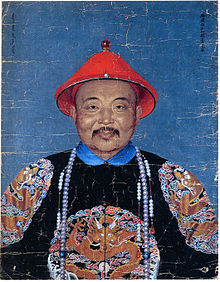Djungarian Khanate

The Dzungarian Khanate was a steppe empire of Zungars , a subgroup of the Mongolian Oirat in which bears their name Dzungaria was that originated around 1638 and destroyed 1759th
Foundation and development
Among the western Mongolian Oirats there were many attempts in the 16th century - especially in competition with the eastern Mongolian Khalka - to gain supremacy in the area and there were repeated conflicts between the tribes involved.
In 1640, at a meeting on the Imil River, the Djungarian khanate was founded by Khungtaidschi Batur . In 1643 he led his horde to the Ili region ( Siebenstromland ). This Oiratengruppe was henceforth as Zungars (of Jüün Ghar called left wing (in Mongolian army)) and claimed sovereignty over the other groups. From 1653 to 1671 his son Khungtaidschi Sengge followed , and from 1671 his other son Galdan , who occupied Kashgaria . Then Galdan turned his attention to the inner Mongolian regions and their overlords, the Qing Dynasty . It failed - in 1696 the troops of the Qing emperor Kangxi (1661–1722) on the Tula near Zuunmod remained victorious, Galdan's wife fell and the Khan probably committed suicide.
Galdan's nephew Tsewangrabtan , with whom Galdan had been enemies, came to power, initially kept peace with China and instead attacked the Kazakhs under Tauke from 1698 onwards. In 1717 Tsewangrabtans army appeared in Lhasa ( Tibet ) where he the regent Lhabzang killed by the Choschuten. This triggered a victorious invasion of Tibet by the Qing Army in 1720 . Another Qing army marched against the Djungarian khanate and won at Urumqi , so that Tsewangrabtan had to make peace in 1724. The Djungars remained successful in 1720 against the better armed Russians at Zaisan.
Tsewangrabtan now turned against the neighbors to the west. The Kazakhs suffered particularly from this. With the defeat of the Kazakhs in 1718 on the Ajagus river (on Lake Balkhash ), the time of the "great misfortune" began. But his relationships with the Oirat Torguten (often called Kalmyks , at that time still a name for all Oirats) of Khan Ayuki (r. 1670–1724) were not the best - there a political marriage ended in conflict.
Tsewangrabtan's son Galdan Tsereng (1727-1745) continued his politics. In 1735 he sent his first tribute embassy to Beijing. In 1739 he concluded a peace treaty with the Khalka, with which the Altai border was established. In 1741 he sent two armies against the Kazak khanate , which defeated Abylai Khan and took prisoner (1741/42), persuaded the khans Abu'l Muhammed and Baraq to position hostages, again devastated the Syr Darya area and as far as the Russian border ( 1744) came. Galdan Tsereng died in August or September 1745.
Downfall
His second son Bayan or Tsewang Dordschi Namdschar was installed as Khan, but was still too young for the office and was therefore deposed in 1750 in a coup by some officers in favor of his older brother Lama Dardscha. Influential relatives - the princes Dawatschi and Amarsanaa - did not accept the new ruler and began a power struggle. The two had to flee before they could defeat their opponents in 1752. Dawatschi became the new ruler, but Amarsanaa fell out with him in 1754 and had to flee again. He found support among the Chinese, who took advantage of the internal quarrels, defeated Dawachi in 1755 and thus conquered the Djungarian khanate.
Amarsanaa turned against the Chinese and instigated an uprising, which was unsuccessful. To prevent new uprisings, the Chinese massacred the Djungars and killed up to 200,000 people in 1757/58. The Ili area or the whole of today's Xinjiang has belonged to China since then. The term Djungars was changed from Chinese historiography to oil solder or oil solder or its use was prohibited. The Chinese name for the jungle empire was also used in Europe.
Individual evidence
- ↑ Oroi-Jalatu is also written Oroi-Jalatu. There are more pictures, e.g. B. by the French artist Jacques Philippe Le Bas
- ↑ According to K. Kollmar-Paulenz: Die Mongolen, p. 95, contemporary Chinese sources calculate that 30% of the 600,000 or so Jungars were murdered, 20% fled to the Russians and Kazakhs and 40% died of the leaves .
- ↑ See GW Leibniz : The correspondence with the Jesuits in China. Meiner, Hamburg 2006, p. 464f. ISBN 3-7873-1623-X .


